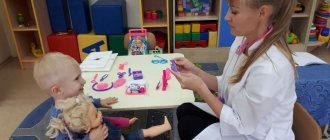MAGAZINE Preschooler.RF
THE PROBLEM OF MANAGING THE PLOT-ROLE-PLAYING PLAY OF A PRESCHOOL CHILDRENIn the modern understanding, a game is “a form of activity in conditional situations aimed at recreating and assimilating social experience, fixed in socially fixed ways of carrying out objective actions, in subjects of science and culture”
At each age stage there is a leading type of activity that has a decisive influence on the formation of personality. Such an activity for a preschooler is a role-playing game, which, thanks to pedagogical guidance, becomes a form of organizing life. “The game in condensed form contains, as if in the focus of a magnifying glass, all development trends; the child in the game seems to be trying to make a leap above the level of his usual behavior,” writes L.S. Vygotsky.
The game is considered by psychologists (Vygotsky L.S., Zaporozhets A.V., Rubinstein S.L., Elkonin D.B., etc.) as the most developed form of creative activity. It is no coincidence that the famous game researcher D.V. Mendzheritskaya consistently defended the name “creative” rather than plot-role-playing games, relying on L.S. Vygotsky, who noted the emergence of a plan in the play activities of preschool children, in implementing which the child reflects social reality, but does not copy it, but combines his ideas about it, conveys his attitude to what is depicted, i.e. creates..
Modern studies of the play activity of preschoolers confirm the correctness of L.S.’s ideas. Vygotsky. It has been established that the formation of a child’s personality occurs through play. It is precisely this that ensures that the preschooler identifies and comprehends socially accepted moral norms of behavior, and forms the main driving motive for the child’s personal development – to be like an adult. The adult becomes the “moral center” of the game for the preschooler, a role model. A new form of motives develops in the game: from pre-conscious, affectively colored immediate desires to generalized intentions (Bozhovich L.I.).
Considering play as one of the “main areas of children’s upbringing before school,” A.P. Usova believes that “game will become a powerful educational factor if it is used in the pedagogical process to organize the lives of children and their activities. This means that the most important manifestations of the life of preschool children, namely their interests, requests, communication, etc. will be organized and satisfied with games and forms of play.”
The importance of role-playing games in the formation of arbitrariness of behavior is especially highlighted in psychological and pedagogical research. Researcher O.A. Karabanova emphasizes that “joint role-playing game... represents the zone of proximal development of the child’s arbitrary behavior, where interaction and cooperation with peers provide the conditions for objectification and further internalization of the ability to regulate one’s activities”
Throughout preschool childhood, the dynamics of play development are observed from the first level (in junior preschool age) to the fourth (in senior preschool age). But, as data from mass practice show, only a small percentage of children reach the fourth level of play development by the end of preschool childhood. This situation certainly affects the general mental and personal development of preschoolers.
When analyzing the features of creative play, the main analyzed characteristic is its content. The content develops from games where the main content is a reflection of the real actions of adults, to games that reflect relationships between people, and, finally, to games in which the main content is submission to the rules of social behavior and relationships.
The content of the game is the essential factor that determines the development of a “good” game. The criteria for such a game are the following:
- the presence of morally and mentally developing content;
- development of imagination and creativity;
- friendliness in relationships;
- the joy of realizing one's strengths.
However, as evidenced by research data (Artemova L.V., Gasparova E.M., Zvorygina E.V., Novoselova S.L., etc.), as well as our observations, in children, kindergarten students, creative play is often is stereotypical. It is often a strictly regulated activity, monotonous and more reminiscent of frontal classes, where everything is predetermined by the teacher and there is no room for the child’s creativity.
Among the reasons for this state of the game are the following:
- lack of understanding in the minds of adults - parents and educators - of the value of children's play.
- the position of the teacher as a passive observer or as a dictator of the child’s actions and behavior in the game;
- the presence of the same toys and attributes in all kindergarten groups, which are too detailed and lead children to the same way of using them;
- insufficient amount of unformed play material to stimulate the child’s imagination.
The more meaningful the game, the more opportunities for the child’s development. In turn, the content of gaming activity depends on the complexity of the goals set. A.N. Leontyev emphasizes that “... in real life... goal formation acts as the most important moment in the formation of one or another activity of the subject... it is necessary to raise the question of goal formation... the selection and awareness of goals is not an automatically occurring and not a one-time act, but a relatively long process of testing goals through action and their, so to speak, substantive content.”
Such identification, testing and substantive filling of activity goals is ensured primarily by the connection between learning and play.
The essence of the relationship between learning and play was revealed at one time in the research of A.V. Cherkova. The psychologist drew attention to the fact that with the introduction of education in kindergartens, the following paradoxical phenomenon began to be observed: in the process of classes, children are imparted a fairly extensive amount of knowledge, but this is reflected insignificantly in the game. A.V. Cherkov comes to the conclusion that when the unity of goals is established in educational activities, work and play, the development of the latter is significantly intensified. To do this, it is necessary to establish as closely as possible a connection between the program material of the lessons and the interests manifested in the game. Subsequently, R.I. Zhukovskaya reveals the types of connections that exist between classes and play.
These are the following types of connections:
- the connection between conducting imaginative didactic games and creative, independent ones;
- the connection between observing people's work on excursions, artistic reading and the development of social interests in the roles of “adults” ;
- the connection between reading works of fiction about our contemporaries, holding conversations about what they read and the subsequent development of interests in games;
- the connection between design learning activities and the development of interests in independent construction games;
- the connection between the development of interest in independent games - dramatizations and the conduct of dramatizations in the classroom [9].
The teacher's purposeful development of these connections leads to a significant increase in gaming interests. However, until now, play in preschool institutions is rarely creative, but is characterized by a reproductive nature. It is not the nature of children to copy ready-made situations, as teachers suggest. A study of mass practice shows that in approximately 30% of cases, educators do not manage role-playing games at all; in 27%, such guidance comes down to the question “What are you playing? ”and only in 29% of cases do teachers take an active part in games (according to L.G. Semushina). Thus, in practice, the importance of play as a means of personality development and as a form of organizing children’s lives is underestimated.
The teacher, unfortunately, is often not perceived by the child as a person involved in the children's community (that is, primarily as a person who plays), as an emotionally interested interpreter of the events of the surrounding life that the child constantly encounters and which interests him.
Analysis of the state of management of children's games shows that most educators do not strive or do not know how to be “together” with children in play as often as possible. Most often, the teacher adheres to the position “above the children,” which is most convenient for him.
Independence, ease, creativity, variety of children's play are its prerequisites. But, like any activity, it does not arise spontaneously, but is formed (but not imposed!) by adults. Therefore, the problem of a teacher mastering the technology of organizing children's play is extremely relevant.
Our observations indicate that the reasons for the teacher’s difficulties in guiding a preschooler’s play are associated, first of all, with the insufficient level of development of his professional and pedagogical skills.
A study of the professional functions of a teacher was conducted by L.G. Semushina. She identified the following groups of skills:
- Analytical skills (the ability to analyze and evaluate the level of development of the play activity of each child and the group as a whole; the ability to analyze and evaluate a specific role-playing game).
- Design skills (the ability to design the level of development of gaming activities, plan management techniques, design the development of a specific role-playing game).
- Information skills (the ability to select material to provide children with impressions, convey it to children in a form accessible to them, arouse interest in it, desire to reflect it in games).
- Organizational and communication skills (the ability to encourage children to agree on the start of the game, choose a topic, discuss a game plan, select and make the necessary equipment, toys and items that replace them).
The formation of the above skills involves the following areas of work in preschool institutions: this is, first of all, the development of pedagogical consciousness. The teacher needs to know the psychology and pedagogy of a child’s play, be able to diagnose the level of development of each child and the group as a whole, and thoroughly study all the phenomena of reality that are the source of children’s play. However, “the high professional level of a preschool teacher presupposes not only the presence of deep knowledge (general and special), but also his ability to educate a creative personality” [12, p. 226]. Therefore, we have highlighted such an area as work on the development of pedagogical thinking. The creativity of a teacher does not allow for simple copying of someone else's experience. To create a model of creative work on the formation of children's play, the teacher needs to skillfully operate with pedagogical knowledge, argue his own opinion (the ability to predict play situations, children's behavior and select adequate methodological techniques).
At the same time, the level of children's play is directly dependent on the guidance of the teacher. And at the same time, play should be a free and independent activity that arises on the child’s initiative. Compulsion to play turns it into a regulated activity. Play is the only type of children's activity where a preschooler can act without coercion, based on his own interests and needs, having the opportunity to freely choose. If this is not taken into account, then the game ceases to be such a free activity.
However, a preschooler, due to his insufficient life experience, cannot yet adequately assess and understand the phenomena of the surrounding reality that are reproduced in his game, and therefore cannot learn moral standards of behavior. To a certain extent, not only the modeling of the education process, but also his creative position in conducting the game depends on the teacher, since it is the teacher who selects the means of influence on the child. Therefore, the main thing in pedagogical activity is to change the nature of interaction between an adult and a child. An adult should take the position not of a passive observer, but of an active partner in the game.
To ensure this, in our opinion, it is necessary:
- the ability to respond to children’s play, to be aware of the emotional state of each participant;
- the ability to change the nature and content of communication with children in accordance with the development of the plot of the games. For this purpose, problematic game situations are used, which are created by changing the object-game environment and activating communication between an adult and children;
- the teacher’s knowledge of the phenomena of reality that are the source of the content of children’s play, his readiness and ability in a certain way to convey information accessible to children’s understanding, to stimulate the manifestation of children’s various creative abilities and children’s activities;
- the ability to select the most appropriate (in connection with the level of development of the game’s plot) means of pedagogical influence that form in the child the image of an adult whom he strives to imitate;
- modeling of possible results of the game, which allows the adult partner to imagine the possible behavior of children in different roles.
Each of these conditions cannot be purely reproductive.
There must be a creative component in the teacher’s activities. When leading the game, he must be able to coordinate his actions and verbal guidelines with constant changes and complications of the plot. The degree of children's interest in the game depends on the position of the teacher as a partner, consultant and senior comrade.
Continuing this thought, it should be noted the importance of the teacher having a professional sense: understanding where and how to get involved in the game, when to come to the rescue in the implementation of the plan or quietly leave the game, giving the children the opportunity to show their creativity, their understanding of what is being depicted.
Guiding play activities requires the teacher to be able, in the role being portrayed, to outwardly express their feelings and thoughts through speech, facial expressions, and movements. Taking a playful position, the teacher promotes the development of independence, initiative, and creativity of children in role-playing games.
LITERATURE
- Psychology: Dictionary/Under general. ed. A.V. Petrovsky, M.G. Yaroshevsky. – M.: Politizdat, 1990. – P.127.
- Vygotsky L.S. Game and its role in the mental development of a child // Issues of psychology. – 1996. – N 6. – P.75.
- Pozdnyak L. Mendzheritskaya D.V. – researcher of play in preschool children. //Preschool education. – 1995. – No. 12. — P.10.
- Usova A.P. Pedagogy of the game and its pressing problems. In the book: The role of play in raising children. – M.: Education, 1976. – P.15.
- Doronova T.N., Karabanova O.A., Solovyova E.V. Game in preschool age. – M.: Publishing House “Education of Preschool Children”, 2002. – P.20.
- Elkonin D.B. Psychology of the game. - M.: Pedagogy, 1978.
- Leontyev A.N. Problems of activity in psychology // Issues of philosophy. – 1972. – N 9.
- Cherkov A.V. Development of conscious relationships in children in play. - Teacher zan. Height. Ped. Institute, 1958. - P. 3-92.
- Zhukovskaya R.I. The game and its pedagogical significance. – M.: Pedagogy, 1975. – 112 p.
- Mikhailenko N., Korotkova N. Towards a portrait of a modern preschooler. // Preschool education. – 1993. – N 1. – P.32.
- Semushina L.G. Study of the professional functions of a preschool teacher. In: Improving the training of preschool specialists. – M.: MGPI, 1982. – P.87.
- Kononko O.L. Social-emotional development of specialness. – K.: Osvita, – 225 p.
| Next > |
Methods and techniques of pedagogical support for play activities of preschool children
Report on the topic: Methods and techniques of pedagogical support for the play activities of preschool children.
The work was completed by: Educator - Tarkhova Irina Alekseevna, MBDOU kindergarten No. 64 “Golden Key”.
Methods and techniques of pedagogical support for the play activities of preschool children.
Play is a free activity, and its developmental effect becomes maximum when it is an independent child activity. It turns out that the nature of children's play conflicts with the established approach of “leading the game.” The transition from the strategy of pedagogical guidance of the game to the strategy of pedagogical support helps to resolve this contradiction.
Pedagogical support for children’s play activities is carried out in the following areas:
• Creation of an object-game environment.
• Organization of situations of playful interaction between the teacher and children, in which the teacher conveys playful methods of action to the children.
• Creating problem-game situations (posing a new game task for children, the solution of which is based on existing experience). Problem-game situations are created through an object-game environment and through playful communication between the teacher and the child.
• The teacher’s participation in children’s games, based on the partnership between the teacher and the child.
The leading idea of pedagogical support for children’s games is to help the child master the conventions of play actions. This determines the tasks of the work aimed at children mastering the game as a special type of activity that requires the following skills:
- include in the game actions with toys and other objects and actions without objects - “figurative” (for example, “eat” a non-existent candy);
- replace well-known objective actions in the game with actions with substitute objects, and then with words;
- convey actions characteristic of the character (“mother”, “doctor”, etc.), and the relationships of the characters (“mother” speaks affectionately to her “daughter”);
- “animate” the toy, attribute desires and emotional states to it;
- verbally explain game actions, substitute objects and imaginary objects (“I feed”, “This is my spoon”);
- in the first half of the year, accept from the teacher the verbally indicated idea of the game (“We will now go to the dacha”); by the end of the year, designate the simplest idea yourself;
- in the first half of the year, with the help of the teacher, by the end of the year independently enter into a short dialogue with the toy;
- independently develop semantic chains of 2-3 game actions, continue the meaningful action started by an adult partner;
— interact with a peer based on the exchange of objective actions.
In the process of personality formation, the game will be able to stimulate:
- awareness of one’s own growth, advancement in knowledge of the world;
- the joy of mastering more advanced methods of activity;
- pleasure from the process of cognitive activity;
- self-esteem;
- pride in a comrade's success.
Teachers begin to turn to gaming pedagogical technologies during the period of education and training of preschoolers. The program of play activities for a preschooler is built from a set of educational games, which, with all their diversity, are based on the general idea of connecting construction, labor and technical games with the child’s intelligence and have characteristic features.
1. psychophysiological justification: the child masters role-playing play, gets acquainted with human relationships, begins to distinguish between the internal and external aspects of phenomena, the child actively develops imagination and the symbolic function of consciousness, which allow him to transfer the properties of some things to others, orientation in his own feelings and skills of their cultural expression are formed - all this allows the child to be involved in collective activities and communication.
2. pedagogical principle: it was possible to combine one of the basic principles of learning “from simple to complex” with the very important principle of creative activity “independently according to ability.”
3. solving pedagogical problems: in educational games the following pedagogical tasks are achieved:
4. development of a child’s creative abilities from a very early age;
5. gaming tasks-steps influence the advanced development of the child’s abilities (according to L.S. Vygotsky, the zone of proximal development is involved);
6. The child’s activities are accompanied by an atmosphere of free, joyful creativity;
7. The child’s activities are accompanied by a situation of success.
The gameplay should flow naturally, children should not have the feeling that they are being “taught”
Features of pedagogical support for children’s play activities:
- is that, interacting with children, the teacher flexibly changes his position depending on the degree of manifestation of independence and creativity, and actively cooperates with them.
- Accompanying interaction helps the child actualize the gaming experience as a result of playing together with the teacher, and apply it in various situations that arise outside the boundaries of the gaming activity specially organized by the teacher.
Pedagogical support for gaming activities involves
- Regular diagnostics of play activity and recording of its results when interacting with children in play.
- The presence of a playing position that combines direct and indirect methods of interaction.
- Selection of game content based on the interests of modern preschoolers.
- The teacher’s orientation towards the individual creative manifestations of children in play and their further development.
- Creation of a modern subject-game environment.
- The teacher needs to develop the ability to be a player, i.e. have your own playing position.
The teacher’s playing position includes:
The teacher’s pronounced interest in children’s games;
Ability:
see the real situation from the outside and identify gaming opportunities in it;
establish trusting relationships with others;
feel the game states of other people;
Creativity as the ability to find non-standard ways to achieve a goal.
A modern approach to organizing creative games for preschoolers
Requires flexible leadership tactics, where the teacher’s position is constantly changing:
The teacher is a partner, a bearer of gaming skills and skills of organized communication in the game.
The teacher is the coordinator of children’s play plans and communication.
A teacher is an observer of children’s games and a consultant in case of difficulties.
Planning a game with your children
Supports spontaneous play, enriches and provides play time and space
Preparation together with the teacher of the attributes of the game
Having taken on the role, the adult indirectly controls the game, leading children out of conflict situations and warning them, unobtrusively using their knowledge to maintain a positive attitude towards the game and partners






